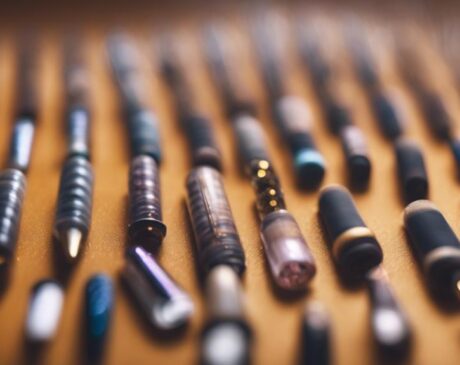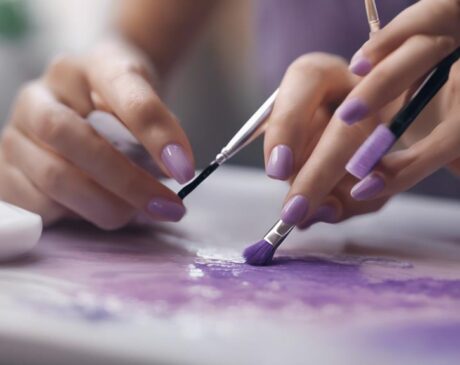Can Rubbing Alcohol Remove Press on Nails?
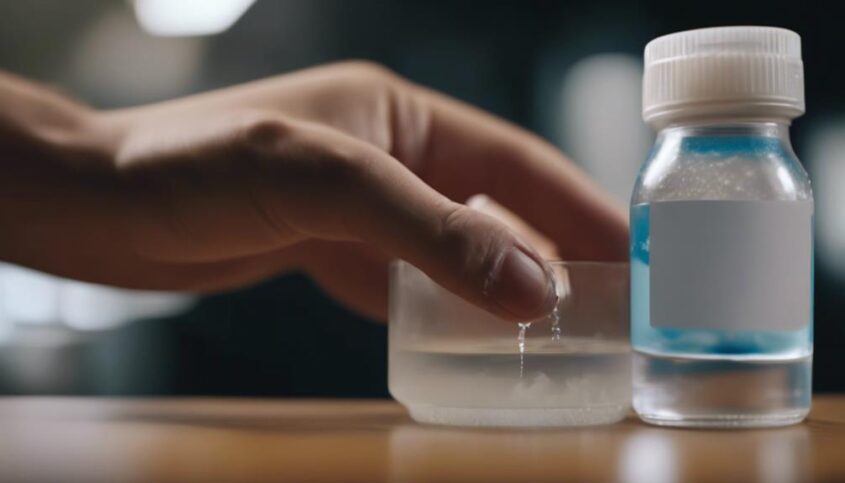
Yes, rubbing alcohol can remove press-on nails effectively by loosening the adhesive. It helps in gently detaching the nails without causing damage. Remember to soak a cotton ball in rubbing alcohol, rub it over the nail, and peel off the press-on nail carefully. Visit both the safety measures section and the aftercare section for effective removal and proper maintenance tips to ensure nail health and strength.
Key Takeaways
- Rubbing alcohol can effectively loosen adhesive on press-on nails.
- It aids in gentle removal without causing excessive damage.
- Moisturize nails post-removal to prevent dryness and brittleness.
- Ensure thorough coverage of rubbing alcohol for efficient dissolution.
- Use a gentle peeling technique to preserve natural nails.
How Does Rubbing Alcohol Work?
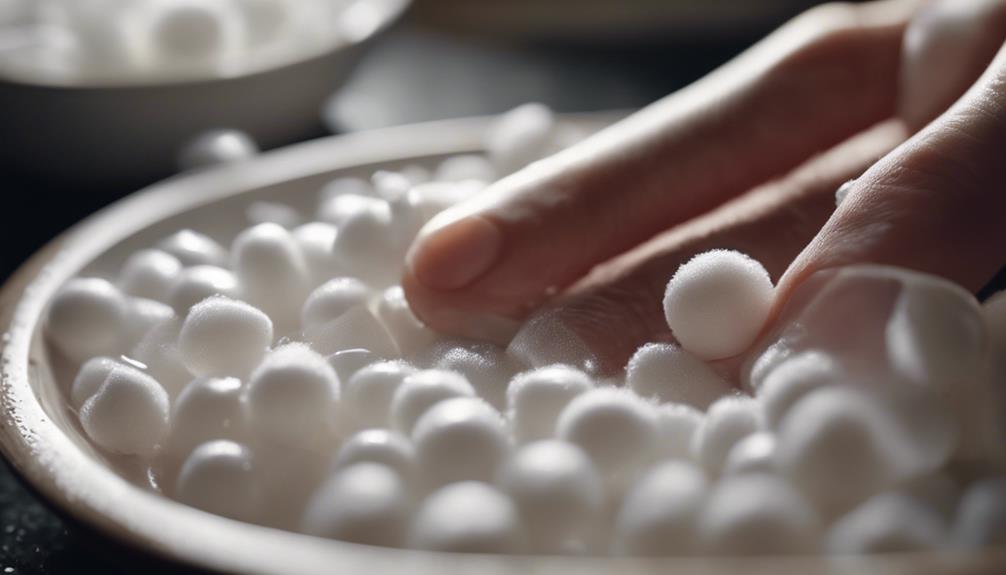
Rubbing alcohol, also known as isopropyl alcohol, functions as a versatile solvent due to its ability to break down and dissolve various substances. This clear, colorless liquid is commonly used in a variety of applications, including cleaning, disinfecting, and as a solvent for a wide range of compounds. Its molecular structure gives it the ability to interact with both polar and nonpolar substances, making it an effective solvent for dissolving oils, greases, and other organic compounds.
Isopropyl alcohol works by disrupting the hydrogen bonding forces that hold molecules together, allowing it to penetrate and break apart substances like dirt, grime, and adhesive residues. Its rapid evaporation rate also makes it a popular choice for cleaning electronics and delicate surfaces, as it dries quickly without leaving behind any residue. Additionally, its antiseptic properties make it a common ingredient in hand sanitizers and disinfectant products. Overall, rubbing alcohol's unique properties make it an essential tool for various cleaning and solvent applications.
Is Rubbing Alcohol Safe for Nails?
Using rubbing alcohol on nails requires careful consideration of its potential effects on nail health and appearance. Rubbing alcohol, also known as isopropyl alcohol, is commonly used for its disinfectant properties, making it effective for cleaning nails before applying polish or artificial nails. However, frequent use of rubbing alcohol can lead to dryness and weakening of the nails. The alcohol can strip the nails of natural oils, leaving them brittle and more prone to breakage.
While rubbing alcohol can help remove residue from press-on nails, it is essential to use it sparingly to minimize damage to the nail bed. To maintain nail health, consider using moisturizing treatments and nail strengtheners after using rubbing alcohol. Additionally, it is advisable to give your nails a break from harsh chemicals occasionally to allow them to recover and strengthen. Overall, while rubbing alcohol can be a useful tool in nail care, it should be used judiciously to prevent adverse effects on nail health and appearance.
Steps to Remove Press on Nails
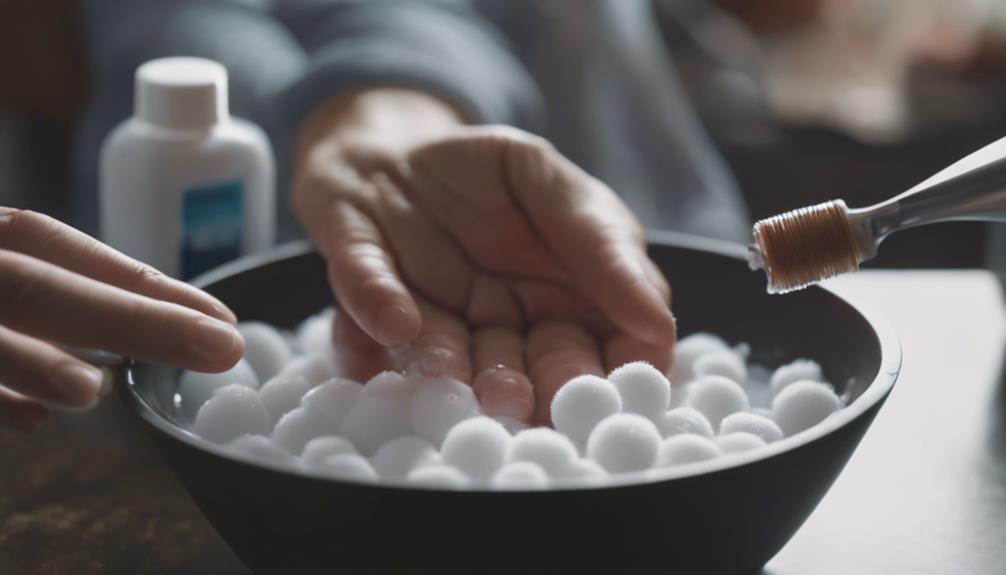
When it comes to removing press-on nails, there are a few key steps to keep in mind. Using rubbing alcohol can help loosen the adhesive, making it easier to peel off the nails gently. Once the nails are removed, remember to moisturize your natural nails to keep them healthy and strong.
Alcohol for Nail Removal
Efficiently removing press on nails can be achieved by utilizing alcohol as a solvent for adhesive dissolution. Rubbing alcohol, known for its ability to break down adhesives, can be a game-changer in the nail removal process. Here is a simple guide on how to use alcohol for nail removal:
| Step | Instructions | Benefits |
|---|---|---|
| 1. Soak cotton pads | Soak cotton pads in rubbing alcohol. | Ensures thorough coverage. |
| 2. Apply to nails | Place the soaked pads on each nail, covering entirely. | Promotes even dissolving. |
| 3. Gently remove | After a few minutes, gently remove the press on nails. | Minimizes nail damage. |
Gentle Nail Peeling
For a gentle approach to removing press on nails, consider beginning by loosening the adhesive with a solvent like rubbing alcohol. After soaking a cotton ball in rubbing alcohol, apply it to the nail and let it sit for a few minutes to help dissolve the glue. Gently wiggle the press on nail back and forth, starting from the sides, to avoid damaging your natural nails. If needed, repeat the process until the nail loosens completely. Remember to be patient and avoid forceful removal to prevent any harm to your natural nails. This method offers a less abrasive way to remove press on nails, promoting nail health and minimizing potential damage.
Moisturize After Removal
After removing press on nails, it is essential to moisturize the nails and surrounding skin to replenish any lost moisture and maintain nail health. Hydrating the nails post-press on nail removal is crucial to prevent dryness, brittleness, and potential breakage. Opt for a nourishing cuticle oil or a rich hand cream containing ingredients like shea butter or jojoba oil to deeply moisturize the nails and skin. Massaging the moisturizer into the nails and cuticles will also help improve blood circulation, promoting healthier nail growth. By incorporating this simple yet effective step into your nail care routine post-press on nail removal, you can ensure your nails remain strong, healthy, and looking their best.
Preparing Your Nails for Removal
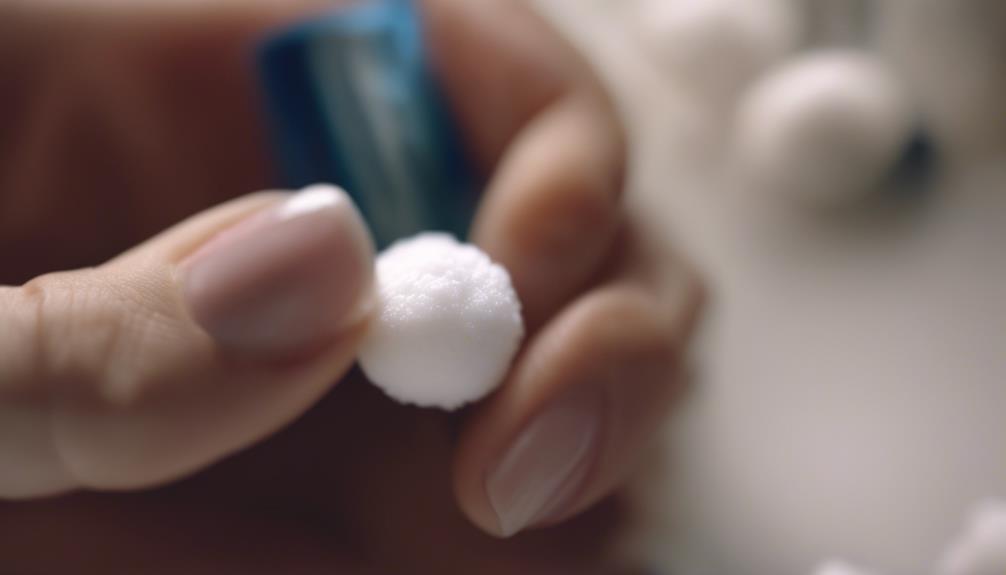
To ensure optimal results when removing press-on nails, proper nail preparation is essential. Begin by trimming the nails to a shorter length using a nail clipper. This step helps prevent any excess pressure or damage to the natural nail bed during the removal process. Next, file the edges of the press-on nails gently to remove any sharp or uneven edges. This will make the removal process smoother and reduce the risk of chipping or peeling the nails.
After trimming and filing, soak your nails in warm, soapy water for about 10-15 minutes to soften the adhesive used to attach the press-on nails. You can also add a few drops of cuticle oil to the water to hydrate and nourish your natural nails. Once the adhesive has softened, gently pry the press-on nails off using a wooden cuticle stick, starting from the sides and working your way towards the center. By following these steps, you can prepare your nails effectively for the removal process, ensuring a clean and damage-free outcome.
Applying Rubbing Alcohol Correctly
Upon successfully preparing your nails for removal, the next step involves applying rubbing alcohol correctly to aid in the process of detaching press-on nails. To ensure an effective removal process, follow these innovative steps:
- Soaking Method: Submerge a cotton ball in rubbing alcohol and place it on the press-on nail. Allow it to sit for a few minutes to help loosen the adhesive bond.
- Gentle Rubbing: Gently rub the soaked cotton ball over the press-on nail, ensuring the rubbing alcohol reaches all edges for thorough detachment.
- Peeling Carefully: Once the adhesive has loosened, carefully peel off the press-on nail from one side to the other to prevent any damage to your natural nails.
- Repeat if Necessary: If the press-on nail doesn't come off easily, repeat the soaking and rubbing process until it loosens completely for a smooth removal.
Tips for a Smooth Removal Process
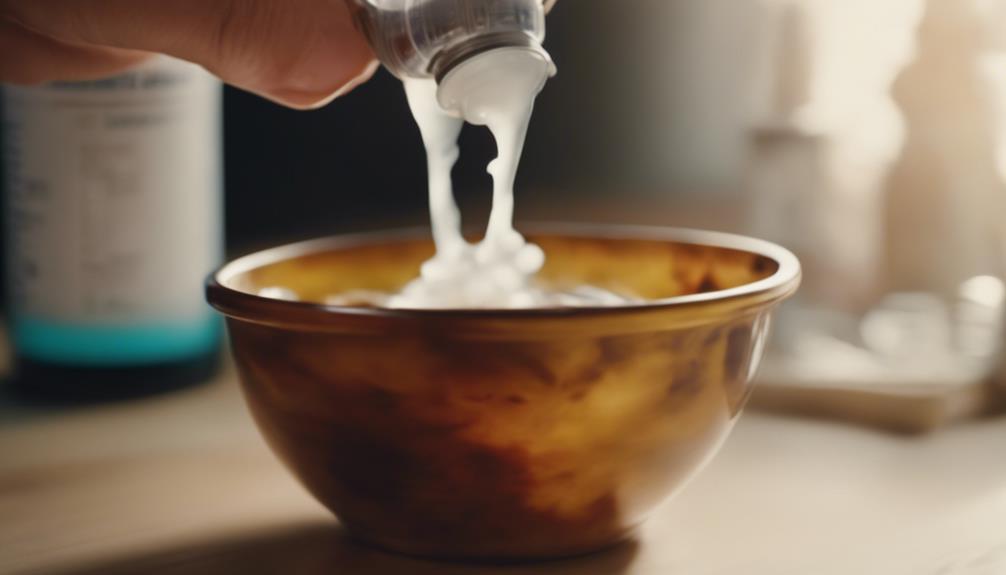
To ensure a smooth removal process when using rubbing alcohol to take off press-on nails, consider soaking the nails in alcohol to loosen the adhesive. Additionally, employ a gentle peeling technique to prevent damage to your natural nails. Finally, don't forget to moisturize your nails and cuticles after the removal process to keep them healthy and hydrated.
Soaking Nails in Alcohol
Soaking nails in alcohol can expedite the removal process of press-on nails while maintaining the health of your natural nails. This innovative technique offers a smooth and efficient way to remove your press-on nails without causing damage. To make the most of this method, consider the following tips:
- Pour rubbing alcohol into a bowl, enough to submerge your fingertips.
- Soak your nails for about 10-15 minutes to loosen the adhesive.
- Gently wiggle the press-on nails to detach them from your natural nails.
- Use a soft cloth to wipe off any remaining residue for a clean finish.
Gentle Peeling Technique
When removing press-on nails, employing a gentle peeling technique can facilitate a smooth and efficient removal process while minimizing any potential damage to your natural nails. To begin, gently lift the edges of the press-on nail using a cuticle stick or a wooden nail stick. Proceed by applying a small amount of cuticle oil or rubbing alcohol to the exposed edge to help loosen the adhesive. Slowly and carefully peel off the press-on nail, moving from side to side to release it from your natural nail bed. Avoid any sudden or forceful movements to prevent nail damage. This method ensures a seamless removal experience, preserving the health and integrity of your natural nails.
Moisturize After Removal
After successfully removing press-on nails using a gentle peeling technique, it is imperative to prioritize moisturization as a crucial step in maintaining the health and appearance of your natural nails. Moisturizing after nail removal helps in revitalizing the nail bed and cuticles, ensuring they remain healthy and strong. Here are some innovative tips for a smooth removal process:
- Use a hydrating nail oil: Applying a nourishing nail oil can help replenish moisture and strengthen your nails.
- Opt for a rich hand cream: Moisturize your hands and nails with a luxurious hand cream to promote soft and supple skin.
- Consider a keratin treatment: Incorporating a keratin treatment can aid in restoring strength and flexibility to your nails.
- Try a collagen-infused nail serum: Collagen-infused serums can enhance nail health and promote growth for a polished look.
Alternatives to Rubbing Alcohol
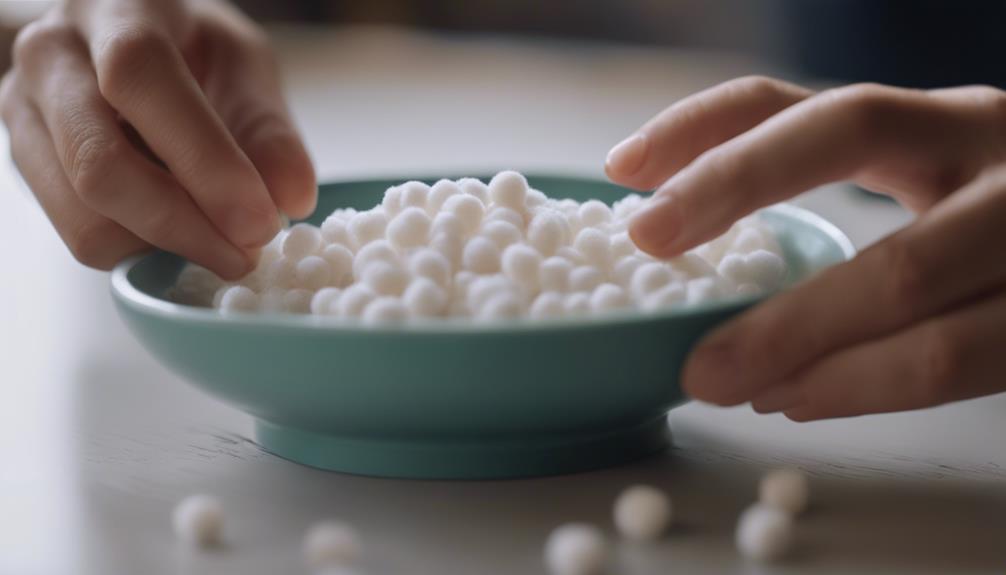
In lieu of rubbing alcohol, other effective alternatives for removing press-on nails include acetone-based nail polish remover and adhesive remover specifically designed for nails. Acetone-based nail polish removers are commonly used for taking off nail polish but can also be effective in loosening the adhesive used in press-on nails. The acetone helps break down the bond between the false nail and your natural nail, making it easier to remove them without causing damage. It is essential to use acetone-based removers in a well-ventilated area and to moisturize your nails afterward to prevent dryness.
Another option is adhesive removers specifically formulated for nails. These products are designed to dissolve nail adhesives gently, minimizing the risk of damaging your natural nails. They offer a targeted approach to removing press-on nails without excessive rubbing or scraping, promoting healthier nail care practices. Experimenting with these alternatives can provide a more efficient and nail-friendly way to remove press-on nails, catering to individuals seeking innovative solutions for their nail care routines.
Aftercare for Your Natural Nails
How can proper aftercare contribute to the health and strength of your natural nails? Taking care of your natural nails is essential to maintain their health and strength, ensuring they look their best. By following a few simple steps, you can keep your nails in optimal condition:
- Moisturize regularly: Hydrating your nails and cuticles with a nourishing oil or cream helps prevent dryness and brittleness.
- Use a protective base coat: Applying a base coat before nail polish can shield your nails from discoloration and damage.
- Keep nails trimmed and shaped: Regularly trimming your nails and shaping them to your desired length can prevent breakage and maintain a neat appearance.
- Avoid harsh chemicals: Minimize exposure to harsh chemicals like acetone and bleach, as they can weaken and damage your nails over time.
Frequently Asked Questions
Can Rubbing Alcohol Damage My Natural Nails?
Using rubbing alcohol on natural nails can potentially weaken them over time, leading to dryness and breakage. It's crucial to follow proper nail care practices to maintain their health and strength.
Will Rubbing Alcohol Remove All Types of Press on Nails, Including Gel or Acrylic?
When considering the removal of press-on nails, it is essential to determine the type of material used. Rubbing alcohol can effectively remove certain types of press-on nails, such as adhesive-based ones, but may not be as effective on gel or acrylic nails.
Can Rubbing Alcohol Be Used to Remove Other Types of Nail Enhancements, Like Dip Powder or Nail Wraps?
Rubbing alcohol is effective in removing various nail enhancements like dip powder or nail wraps. Its solvent properties break down the adhesives, facilitating removal. However, for specific products, it's advisable to consult with a professional technician for optimal results.
Is It Safe to Use Rubbing Alcohol on Nail Extensions or Artificial Nails?
While nail extensions and artificial nails have become popular choices for enhancing one's appearance, caution should be exercised when considering the use of rubbing alcohol. Its impact on these enhancements can vary, so research is essential.
Will Rubbing Alcohol Dry Out My Natural Nails or Cause Them to Become Brittle?
Using rubbing alcohol on natural nails can lead to drying and potential brittleness due to its dehydrating properties. It's advisable to limit its use and follow up with moisturizing treatments to maintain nail health.

